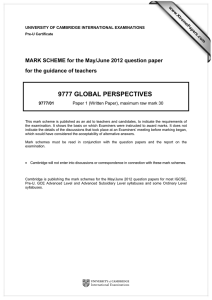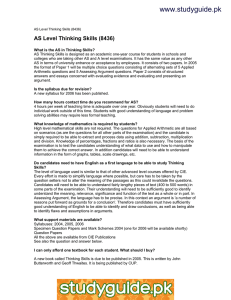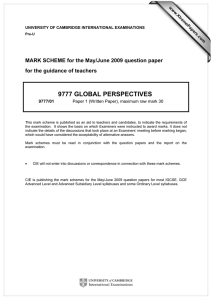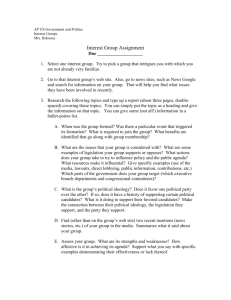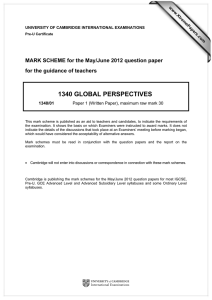9777 GLOBAL PERSPECTIVES MARK SCHEME for the May/June 2010 question paper
advertisement
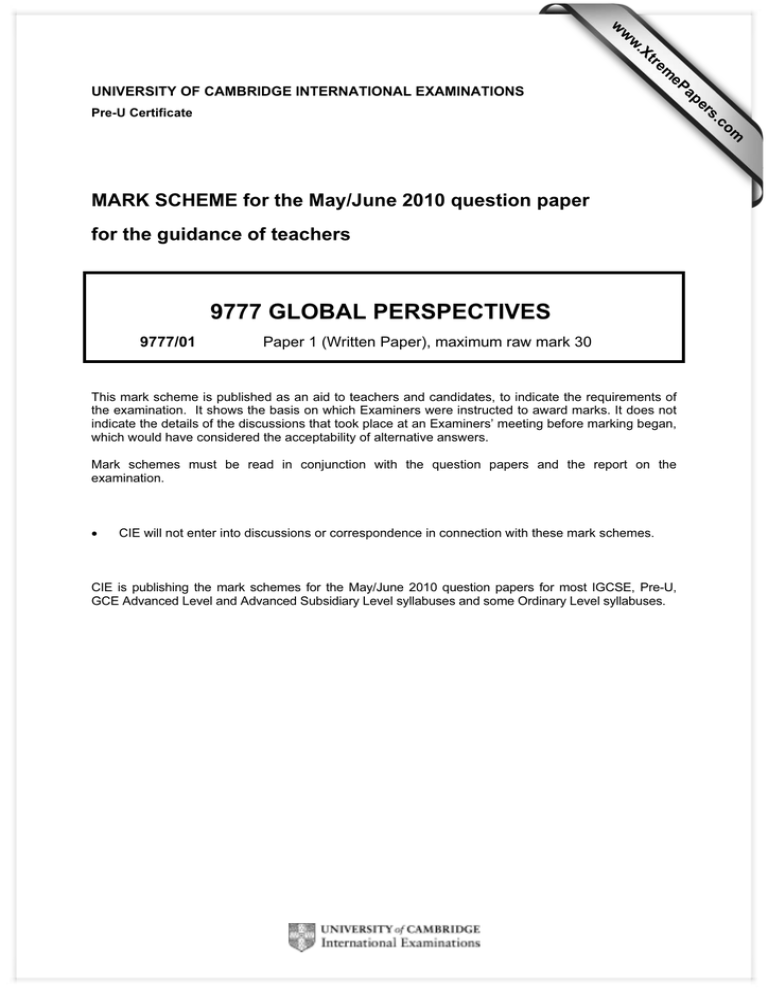
w w ap eP m e tr .X w UNIVERSITY OF CAMBRIDGE INTERNATIONAL EXAMINATIONS s er om .c Pre-U Certificate MARK SCHEME for the May/June 2010 question paper for the guidance of teachers 9777 GLOBAL PERSPECTIVES 9777/01 Paper 1 (Written Paper), maximum raw mark 30 This mark scheme is published as an aid to teachers and candidates, to indicate the requirements of the examination. It shows the basis on which Examiners were instructed to award marks. It does not indicate the details of the discussions that took place at an Examiners’ meeting before marking began, which would have considered the acceptability of alternative answers. Mark schemes must be read in conjunction with the question papers and the report on the examination. • CIE will not enter into discussions or correspondence in connection with these mark schemes. CIE is publishing the mark schemes for the May/June 2010 question papers for most IGCSE, Pre-U, GCE Advanced Level and Advanced Subsidiary Level syllabuses and some Ordinary Level syllabuses. Page 2 Mark Scheme: Teachers’ version Pre-U – May/June 2010 Syllabus 9777 Paper 01 NB: The AOs are inter-dependent and it is thus not feasible to see them discretely so the marking of all answers will be holistic. AO1 AO2 AO3 Analysis and evaluation of arguments Critical analysis and evaluation of argument structure: • to understand and apply the language of reasoning; • to analyse the structure of argument, by identifying the conclusion, reasons (premises), assumptions and any counter-argument; • to assess the technical strength/weakness of the argument by testing the acceptability, relevance and sufficiency of the premises to support the conclusion. Analysis and evaluation of contexts Situating the argument in its context: • identify and evaluate the use of key expressions and ideas, clarifying them as needed; • assess the credibility of sources (collected by the candidate); • identify alternative/rival perspectives and assess their relationship to the case presented; • identify desirable ends/outcomes from which to judge rival perspectives. Presentation, communication and collaboration: • use language and other appropriate media to convey complex concepts and ideas with clarity; • establish a context or framework of understanding sufficient for Communication audiences to understand and respond to the presentation; • demonstrate ability to create a coherent and well-elaborated personal perspective and articulate its relationship to alternative perspectives. There is no requirement to use technical Critical Thinking terms to access any level, and candidates will NOT be rewarded for their use unless they link them directly to the demands of the question. © UCLES 2010 Page 3 1 Mark Scheme: Teachers’ version Pre-U – May/June 2010 Syllabus 9777 Paper 01 Study Document 1 (a) Summarise the main reasoning against GM crops in Document 1. [4] The question requires candidates to summarise the argument, not simply copy out relevant phrases. Candidates should be able to identify that Document 1 is opposed to the introduction of GM crops and, therefore, should not be rewarded for just stating that. At the lower end, candidates should refer to the damage to the environment. This could then be developed for a further mark. This might include reference to the impact on wildlife. Candidates might cover the impact on small farmers and the development of agribusiness, which the Document argues is present in all areas of Britain. (b) How convincing is Juniper’s argument against GM crops? [12] (In your answer, you should evaluate the evidence and reasoning in Document 1.) • Responses should focus on both the strengths and weaknesses of the argument put forward in Document 1. • At Level 1, candidates may consider only one side (e.g. weaknesses). • To reach Level 3, candidates must consider both the strengths and weaknesses. • At Level 2, there is likely to be imbalance, with most of the answer focusing on one side of the reasoning (strengths or weaknesses). Level 3 9–12 marks Level 2 5–8 marks Level 1 1–4 marks Sustained evaluation of strengths and weaknesses of reasoning and evidence, critical assessment with explicit reference to how flaws and counter argument weaken the claim. Highly effective, accurate and clearly expressed explanation and reasoning; clear evidence of structured argument/discussion, with conclusions reached/explicitly stated in a cogent and convincing manner. Some evaluation of strengths and weaknesses of reasoning and evidence, but evaluation may focus on one aspect; assessment of flaws etc may not link clearly to the claim. Effective and generally accurate explanation and reasoning; some evidence of structured argument/discussion; conclusions may not be explicitly stated or link directly to the analysis. Little or no evaluation of strengths and weaknesses, although flaws etc may be identified. Level of communication is limited, response may be cursory or descriptive; communication does not deal with complex subject matter. © UCLES 2010 Page 4 Mark Scheme: Teachers’ version Pre-U – May/June 2010 Syllabus 9777 Paper 01 Responses must focus on evaluation and not simply repeat the argument given in answer to 1(a). Candidates may use a variety of criteria to evaluate the evidence and no set criteria are to be expected. There is much material that candidates might consider, for example: Weaknesses They may suggest that the supporting evidence is generalised and lacks specific detail, e.g.: ‘Wildlife in full retreat’, ‘birds gone from large areas of the country’ ‘the insects that brighten our summers and that are the food of the young wild birds go as well’. No specific figures or evidence of the bird types that have disappeared are given. They may suggest that there is little to no evidence given to support the argument about the decline of the small farmer. They might take notice of the author and his purpose. Candidates might take note of the language used in Document 1; there is plenty of evidence of emotive language that could be used, e.g.: ‘full retreat’, ‘assaulted every corner of these small islands’, ‘war against wildlife’ ‘dustbin of history’. Candidates might discuss how Document 1 uses this language to show how a rural idyll has been damaged. They might comment on reference to the evidence of trials, to which Document 1 keeps referring, without using any specific evidence. No evidence is given to show that the trials have confirmed the arguments put forward by the Friends of the Earth. They may refer to the many sweeping and unsupported statement put forward. Strengths When considering the strengths of Juniper’s argument, candidates might suggest that Document 1 does pursue a logical argument that the loss of plant food for insects will result in a decline in the population of birds and other wildlife that rely on insects for their food. Some answers might suggest that although Document 1 is lacking in specific supporting details, the views put forward are supported by an official study and that this might make the argument more convincing. © UCLES 2010 Page 5 2 Mark Scheme: Teachers’ version Pre-U – May/June 2010 Syllabus 9777 Paper 01 Study Documents 1 and 2 How successfully does the perspective in Document 2 challenge the perspective in Document 1? [14] Responses should focus on key reasons and evidence in both documents in order to compare alternative perspectives and synthesise them to reach a reasoned judgement. In order to assess how successfully Document 2 challenges Document 1, candidates should consider not only the content of the Documents, but critically assess the arguments put forward through a consideration of issues such as purpose and language. • At Level 1, there will be little comparison of the passages or evaluation. Candidates may simply describe the documents or identify areas of similarity and difference. • To reach Level 3, candidates will offer a sustained judgement about whether the reinforcement or challenge is effective. In order to do this, they will have covered a significant range of issues, and evaluated them clearly. • At Level 2, there will be some evaluation and comparison, but it will be either poorly developed or limited in the areas covered. Level 3 10–14 marks Level 2 5–9 marks Level 1 1–4 marks Answers will demonstrate a sustained judgement about whether the reinforcement or challenge is effective. There will be sustained evaluation of alternative perspectives; critical assessment with explicit reference to key issues raised in the passages leading to a reasoned and sustained judgement. Highly effective, accurate and clearly expressed explanation and reasoning; clear evidence of structured argument/discussion, with conclusions reached/explicitly stated in a cogent and convincing manner. Answers will be more than just a comparison of the two documents; there will be some evaluation, but this will not be sustained and may focus on one perspective; assessment may not link key reasons and evidence clearly to the perspective or to the reasoned judgement. Effective and generally accurate explanation and reasoning; some evidence of structured argument/discussion; conclusions may not be explicitly stated or link directly to analysis. Answers will compare a few points and there will be little or no evaluation of perspectives, although some relevant evidence or reasons may be identified. If there is any judgement it will be unsupported or superficial. Level of communication is limited; response may be cursory or descriptive; communication does not deal with complex subject matter. © UCLES 2010 Page 6 Mark Scheme: Teachers’ version Pre-U – May/June 2010 Syllabus 9777 Paper 01 Candidates may consider issues such as the origin of the Documents and the groups that the authors represent. This could lead on to a discussion of the purpose of each Document, which might lead to the conclusion that both Documents have their limitations. Candidates may take the main focus of the argument in Document 1 (that GM crops damage the environment) and suggest that little precise evidence is given, whereas in Document 2, the argument is put forward that GM crops can benefit the environment, pointing to a decline in soil erosion and the protection of 400 million acres of land. They may question the sweeping statement in Document 2 that ‘these areas provide food and shelter for wildlife’ as this is not supported by any evidence. Candidates may compare the argument put forward in Document 1, which is based only on the British government’s GM crop trials, with the evidence in Document 2 that claims to be based on the most studied and reviewed foods in the world. They may suggest that as the conclusions in Document 2 are based on a much wider range of studies and tests, it does successfully challenge Document 1. Candidates may consider the advantages that are put forward in Document 2 for the use of GM crops which are not considered in Document 1. These may include health benefits and economic potential for the developing nations. However, this might be balanced against arguments that suggest the evidence may be selective or that Document 1 is based on a study of the impact on the UK, whereas Document 2 places the development of GM crops in a global perspective and that this may explain the different conclusions. Candidates should critically assess the use of examples and evidence. No set answer is expected. What matters is the quality of the reasoning used by the candidate to reach her/his judgement. © UCLES 2010
